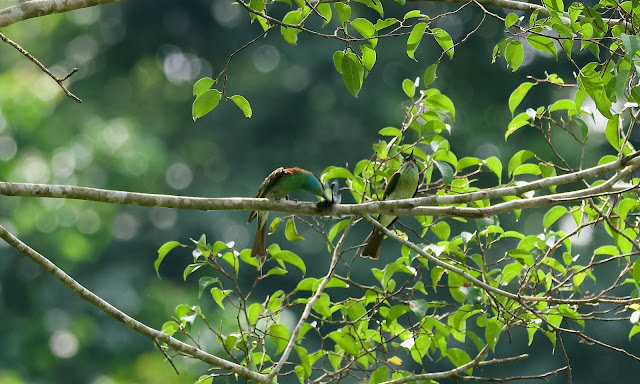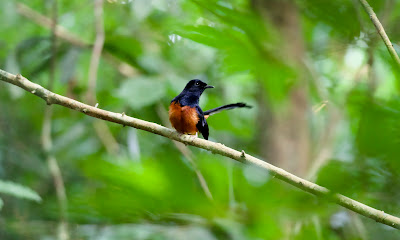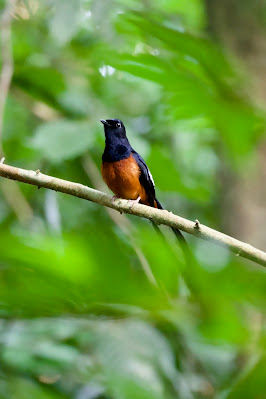Accipitriformes - Accipitridae - Nisaetus alboniger (Helang-Hindik Melayu)
31 July 2025
Blyth's Hawk-Eagle
29 July 2025
Green Iora
Passeriformes - Aegithinidae - Aegithina viridissima (Kunyit-Kecil Hijau)
On seeing and being seen, who's the catcher, who's the captive?
23 July 2025
Blue-throated Bee-eater
Corasiformes - Meropidae - Merops viridis (Beberek Leher Biru/Berek-berek Rengkung Biru)
21 July 2025
Greater Coucal
Cuculiformes - Cuculidae - Centropus sinensis (Bubut Besar Asia)
A large bird that resembles a cross between a crow and a pheasant. Largely black with distinctive rusty wings, glossy underparts, a long and heavy black tail, and deep red eyes. Juveniles are much duller with white bars on the tail and underparts and variable amounts of black streaks on the wings and upperparts. Common across a range of habitats except very dense forests. Similar to Lesser Coucal, but Greater Coucal is larger with a longer bill and red eyes. Adult Greater Coucals also lack the white streaks on the wings seen on Lesser Coucal. The call is a series of deep, resonant “oop-oop-oop” notes.
20 July 2025
White-rumped Shama
Passeriformes - Muscicapidae - Copsychus malabaricus (Murai-Hutan Biasa)
18 July 2025
Lesser Fish-Eagle
Accipitriformes - Accipitridae - Icthyophaga ichethyaetus (Helang-Kanguk Kecil)
Gray-brown eagle with piercing yellow eyes and an immaculate white belly. Juvenile paler and browner than adult, with weakly streaked underparts. Most easily separated from larger Gray-headed Fish-Eagle in flight: note Lesser’s “dirtier” tail with a less contrasting black band and more mottled underwings in adult; note overall paler underside patterning in juvenile. White belly also tends to have a more poorly-defined and jagged shape than the sharp “V” of Gray-headed. Favors faster-flowing foothill streams and rivers, but can also be found in lowland lakes and wetlands.14 July 2025
Blue-winged Leafbird
Passeriformes - Chloropseidae - Chloropsis moluccensis (Burung-Daun Biasa)
Beauty is always beheld only when one truly opens up to see.
13 July 2025
Blue-winged Leafbird
Passeriformes - Chloropseidae - Chloropsis moluccensis (Burung-Daun Biasa)
It can't be faith if it's seeing only after you have seen.
11 July 2025
Large Cuckooshrike
Passeriformes - Camphagidae - Coracina larutensis (Selancang-Punai Besar Biasa)
A large gray cuckooshrike endemic to the hill and montane forests of peninsular Malaysia. Gray above with black primaries; also note strong, slightly hooked bill. Male has a darker face, while female generally has more apparent pale barring on the lower belly. Both sexes have a dark patch from the bill to slightly behind the eye, giving a masked impression. Call is a two-noted, rather nasal squeal-screech: “gii-yaak,” uttered in flight as well as from a perch. Formerly treated as a subspecies of “Large Cuckooshrike”, along with Oriental Cuckooshrike and Indian Cuckooshrike.





















































